By Timothy Pass, BSc (Physiotherapy)
It goes without saying that low back pain is a big deal in healthcare. In fact, 1 in 6 Australians suffer from low back pain at any one time and over 80% of us will experience low back pain at least once in our lifetime. It also represents a considerable cost to society, with the total annual spending on low back pain management in Australia estimated to be over $1 billion.
So, what can be done about it? Today I will share with you some information about low back pain, based on both the latest research and my experience as a physiotherapist. We will also look at a specific management approach that I have used successfully with my patients.
Firstly, let’s be clear on the two broad categories of low back pain – acute and chronic.
Acute low back pain is a recent episode of pain that has been present for less than 6 weeks. Quite often, acute low back pain will resolve on its own, or with the help of treatment (e.g. anti-inflammatories, heat, physiotherapy etc).
Chronic low back pain refers to pain that has lasted for more than 3 months. This type of low back pain is the most problematic and the most difficult to treat.
What Causes Low Back Pain?
The initial cause of low back pain can vary. In the acute stage, it may be the result of a strain or sprain (e.g. muscle, joint or disc). It can result from a single incident or be the result of repeated or sustained stress on the structures of the lower back.
Chronic low back pain, however, is more complex. According to researchers, 85% of chronic low back pain cases cannot be attributed to a specific ‘diagnosis’, or structural problem in the lower back. Even when abnormalities are identified on scans, they cannot always be assumed to be directly correlated with the person’s pain.
Most commonly, chronic low back pain exists because of a combination of factors. These can include not only physical factors, but psychological and social factors as well. In the absence of a specific diagnosis in most low back pain cases, it is vitally important to identify the specific factors contributing to the pain and modify them.
A Management Approach: Identify and Modify LOAD
The majority of low back pain cases that I have seen have, at least partly, resulted from an abnormality in one modifiable factor – LOAD.
Load, as it relates to low back pain, can take many forms. It could be extrinsic (i.e. caused by external factors), or intrinsic. By intrinsic load, I am referring to excessive loading of the lumbar spine due to deficiencies in other parts of the back or body. Examples of extrinsic and intrinsic loads include:
EXTRINSIC LOAD EXAMPLES
- Sustained load from excessive sitting.
- Repetitive load from a specific action or activity (e.g. gardening, domestic cleaning tasks).
- Excessive load from heavy lifting.
INTRINSIC LOAD EXAMPLES
- Poor posture resulting in abnormal loading of the lumbar spine.
- Poor movement patterns causing abnormal loading of the lumbar spine (usually due to poor muscle control, or perhaps specific muscle weakness or tightness).
- Excessive body weight causing abnormal loading of the lumbar spine.
- Stiffness in a facet (spinal) joint causing increased load on an adjacent facet joint.
Regardless of whether the load is extrinsic or intrinsic, in the majority of cases it can be modified. The important first step is to accurately identify the activity (or activities) that may be causing abnormal loading of your spine. From there, changes can be made to reduce this load and therefore reduce your pain.
Extrinsic load can often be modified by making some simple changes to your daily life. It may be as simple as sitting less (or taking regular breaks from sitting), taking regular breaks from an aggravating activity (or avoiding it altogether), asking for assistance for certain tasks, or delegating the tasks to someone else. Intrinsic load is often more difficult to identify and modify, but can be done so with the help of a physiotherapist. However, certain intrinsic factors (such as body weight) may be modified independently.
Knowledge is Power
Simply being aware of the loads that are contributing to your low back pain can be incredibly empowering. A knowledge of the cause and nature of your low back pain can give you a greater sense of control over your pain, and will allow you to manage it more effectively. Understanding your low back pain, and identifying and modifying abnormal loads are important first steps towards recovery from low back pain.
Other Management Approaches
There is an abundance of treatment options for low back pain, some of which are more effective than others. I won’t attempt to describe them all here. However, it is important to remember that everyone is different and therefore treatment for low back pain should be individually tailored. Your physiotherapist will be able to assess your low back pain, identify the causes, discuss your needs with you, and provide you with an effective treatment plan.
*Please note the above advice is general and for informative purposes only. For management and advice specifically tailored to your needs, please call us on 0422 005 900 to book an appointment.
References:
Casiano VE, De NK. Back Pain. InStatPearls [Internet] 2019 Feb 24. StatPearls Publishing. Available from:https://www.ncbi.nlm.nih.gov/books/NBK538173/ (last accessed 21.1.2020)
O’Sullivan P.Diagnosis and classification of chronic low back pain disorders: maladaptive movement and motor control impairments as underlying mechanism. Man Ther. 2005;10:242–255.
Peter B O’Sullivan, J P Caneiro, Mary O’Keeffe, Anne Smith, Wim Dankaerts, Kjartan Fersum, Kieran O’Sullivan. Physical Therapy, Volume 98, Issue 5, May 2018, Pages 408–423, https://doi.org/10.1093/ptj/pzy022
ABS 2019b. Microdata: National Health Survey, 2017–18, detailed microdata, DataLab. ABS cat. no. 4324.0.55.001. Canberra: ABS. Findings based on AIHW analysis of ABS microdata.
Raspe H, Matthis C, Croft P & O’Neill T 2004. Variation in back pain between countries: the example of Britain and Germany. Spine 29:101–1021.
AIHW 2016a. Australian Burden of Disease Study: impacts and causes of illness and death in Australia 2011. Australian Burden of Disease Study series no. 3. Cat. no. BOD 4. Canberra: AIHW.
AIHW 2016b. Back problems, associated comorbidities and risk factors. Canberra: AIHW.

